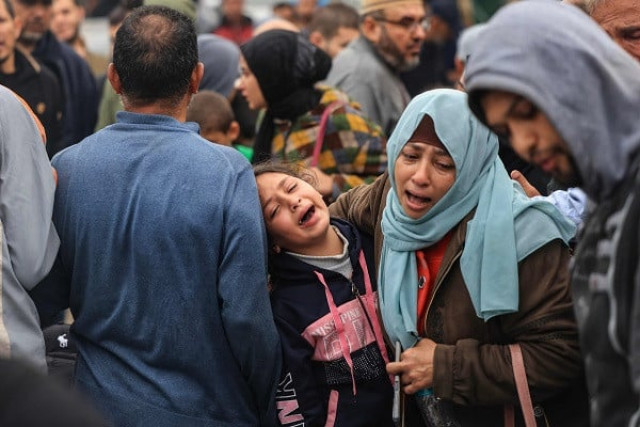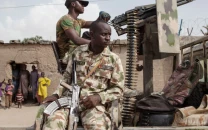Israeli army says Jabalia refugee camp in Gaza surrounded
Hamas fighters battle Israeli invasion forces in southern Gaza

The Israeli army said on Tuesday that it had surrounded the Jabalia refugee camp in Gaza after destroying what it called “terrorist infrastructure”, Al Jazeera reported.
Jabalia camp, the largest in Gaza, has already been the target of Israeli air attacks multiple times since October 7, resulting in the killing of hundreds of people and destruction of infrastructure.
As per the latest reports, Israel had ramped up attacks across the Gaza Strip, including near hospitals and in the south of the besieged enclave where the ground operation was being intensified.
Quoting the Norwegian Refugee Council’s chief, Al Jazeera stated that, “Israel’s indiscriminate bombardment of Palestinian civilians in southern Gaza has reached new depths.”
Speaking of last night’s attacks, Hani Mahmoud - reporting for the Qatar-based media house from Gaza - said “this has been a very, very tough night for Palestinians living in the Gaza Strip, particularly for residents in Khan Younis city and Rafah city, and the 1.5 million evacuees who have been pushed south by the Israeli military to avoid getting bombed in northern Gaza”.
Khan Younis under intense attack these moments pic.twitter.com/D0NpzORr4m
— Gaza Report - اخبار غزة (@gaza_report) December 5, 2023
There were reports of continuous heavy artillery shelling, air strikes and mass bombardment since early yesterday evening, he reported.
“The vast majority of residential homes and public facilities – schools, hospitals, medical centres and shops – in the eastern side of Khan Younis, have been completely destroyed. At the same time, people were ordered to evacuate in the middle of the night and early hours of this morning under heavy bombardment.”
Ambulances trying to get to the eastern side of Khan Younis to Abasan al-Kabira and Bani Suheila were shot at, severely impeding evacuation efforts for the injured, or retrieve bodies of those killed overnight.
Resistance fighters battle invading Israeli forces
Hamas resistance fighters battled invading Israeli troops in the southern Gaza Strip on Tuesday, after the Israelis expanded their offensive deeper into the besieged territory, with warnings that an "even more hellish scenario" was unfolding for trapped civilians.
Israel had initially focused its offensive on the north of the territory, but the army has now also dropped leaflets on parts of the south, telling Palestinian civilians there to flee to other areas.

Israeli soldiers operate in the Gaza Strip amid the ongoing conflict between Israel and the Palestinian resistance group Hamas. PHOTO: Reuters
Israeli tanks, armoured personnel carriers and bulldozers were seen on Monday near the southern Gaza city of Khan Yunis, which is packed with civilians who fled their homes further north in the territory earlier in the war, witnesses told AFP.
An AFP journalist in Rafah near Gaza's border with Egypt saw smoke rising late Monday from buildings in southern Gaza after Israeli bombardment.
The army said Monday it was taking "aggressive" action against "Hamas and other terrorist organisations" in Khan Yunis, warning that the main road in the north and east of the city "constitutes a battlefield".
Hamas claimed via Telegram its fighters had targeted two personnel carriers and a tank near Khan Yunis.
Its military branch also said it had fired rockets towards Beersheba in southern Israel on Tuesday, while the Israeli military said rocket warning sirens sounded there.
As Israel's offensive pushes deeper into Gaza, international aid organisations have warned that civilians in the densely populated territory are running out of places to flee to.
"Nowhere is safe in Gaza and there is nowhere left to go," said Lynn Hastings, UN humanitarian coordinator for the Palestinian territories.
"If possible, an even more hellish scenario is about to unfold, one in which humanitarian operations may not be able to respond," Hastings said in a statement.
The Palestinian health ministry in Gaza says the war has killed nearly 15,900 people in the territory, around 70 percent of them women and children.
In the city of Rafah near the Egyptian border, resident Abu Jahar al-Hajj said an air strike near his home felt "like an earthquake".
"Pieces of concrete started falling on us," he said.
In Deir al-Balah further to the north, Walaa Abu Libda found shelter at a hospital but said her four-year-old daughter remained trapped under rubble.
"I don't know if she is dead or alive," said Libda, one of an estimated 1.8 million people displaced in Gaza -- roughly three-quarters of the population, according to UN figures.
Three more Israeli soldiers were killed in fighting in the Gaza Strip, the army said on Tuesday, raising the number of troop deaths there to 78.
The Israeli army on Tuesday denied telling the World Health Organization to empty an aid warehouse in southern Gaza within 24 hours before ground operations in the area render it unusable.
On Monday, WHO chief Tedros Adhanom Ghebreyesus wrote on X that his organisation had received a notification from the military "that we should remove our supplies from our medical warehouse in southern Gaza within 24 hours".
Key ally the United States has cautioned Israel to do more to avert civilian casualties as operations shift to the south.
Israel on Monday claimed it was not seeking to force Palestinian civilians to permanently leave their homes, but that it was instead seeking support from aid groups to improve infrastructure in a tiny coastal area of Gaza named Al-Mawasi.
"We have asked civilians to evacuate the battlefield and we have provided a designated humanitarian zone inside the Gaza Strip," Israeli military spokesman Jonathan Conricus said.
Speaking on condition of anonymity, senior Israeli military officials admitted that around two civilians have been killed for every dead Hamas fighter in the Gaza Strip. To date, Israeli forces have shown no evidence of captured or killed Hamas fighters.
"Hopefully it (the ratio) will be much lower" in the coming phase of the war, one of the officials added.
To that end, the officials claimed, the army is using high-tech mapping software to track population movements inside the Gaza Strip and issue evacuation orders.
The system incorporates mobile phones and other signals, aerial surveillance and word from local sources, as well as AI, to maintain a constantly updating map showing population concentrations across the territory.
But the UN Humanitarian Office (OCHA) has questioned the usefulness of such a tool in an area where access to telecommunications and electricity is sporadic.
On Monday, all mobile and telephone services were cut across Gaza "due to the cut-off of main fibre routes from the Israeli side", according to Palestinian telecommunications firm Paltel.
On Tuesday, global network monitor Netblocks confirmed Gaza residents were experiencing "a total loss of communications".
The latest fighting followed the collapse last Friday of a Qatar-mediated truce that saw scores of Israeli and other captives released in exchange for Palestinian prisoners.
According to the Israeli military, at least 137 captives are still being held in Gaza, but Hamas has ruled out more releases until a permanent ceasefire is agreed.
The war has sparked fears of a wider regional conflict, with frequent exchanges of fire with Hezbollah across Israel's border with Lebanon.
On Tuesday, the Israeli military said its fighter jets had struck Hezbollah positions in response to launches on Monday from Lebanon into Israel.
The Israel-occupied West Bank has also seen a surge in violence, with more than 250 Palestinians killed there since the war began, according to Palestinian authorities.



















COMMENTS
Comments are moderated and generally will be posted if they are on-topic and not abusive.
For more information, please see our Comments FAQ